Sorghum
Sorghum bicolor;Black Seeded Sorghum
Sorghum bicolor
Sorghum is a secondary noxious weed in Iowa because it can cause problems in corn and soybean fields, but it is also planted as a crop for syrup and grain. Horticultural selections have been made for color and height. Ornamental sorghum is an easily grown annual. The attractive seed heads can be used for fresh or dried arrangements. Many of the available selections are very tall and are a dramatic backdrop for other plants.
Sorghum is a coarse, erect grass. Its growth characteristics can vary quite drastically and a fully matured plant can range in height from 0.45 to over 5 m. Sorghum is often fed to lactating cows, while grazing of sorghum crops by beef cattle is done on a more limited basis. Sorghum must be supplemented with protein, calcium, and other minerals, and must be cracked, rolled, or steam flaked for best animal digestibility.
Habitat: cultivated fields – especially cereal crops
Life cycle: annual
Growth Habit: 4-8 feet tall; resembles corn, but smaller
Leaves: 1-2.5 inch wide blades with white midveins
Inflorescence: July – October. Large panicles of rounded shiny black or red seeds that shatter easily.
Stem: smooth.
Root: fibrous root system; often forms brace roots as well
Similar plants: Shattercane resembles forage sorghum and corn. It is also similar to johnsongrass (Sorghum halepense), but lacks rhizomes and has tighter panicles and wider leaf blades. Shattercane is an annual, while johnsongrass is a perennial.
USES
Sorghum is used for food, fodder, and the production of alcoholic beverages. It is drought tolerant and heat tolerant, and is especially important in arid regions. It is an important food crop in Africa, Central America, and South Asia, and is the “fifth most important cereal crop grown in the world”.


 Secured By miniOrange
Secured By miniOrange